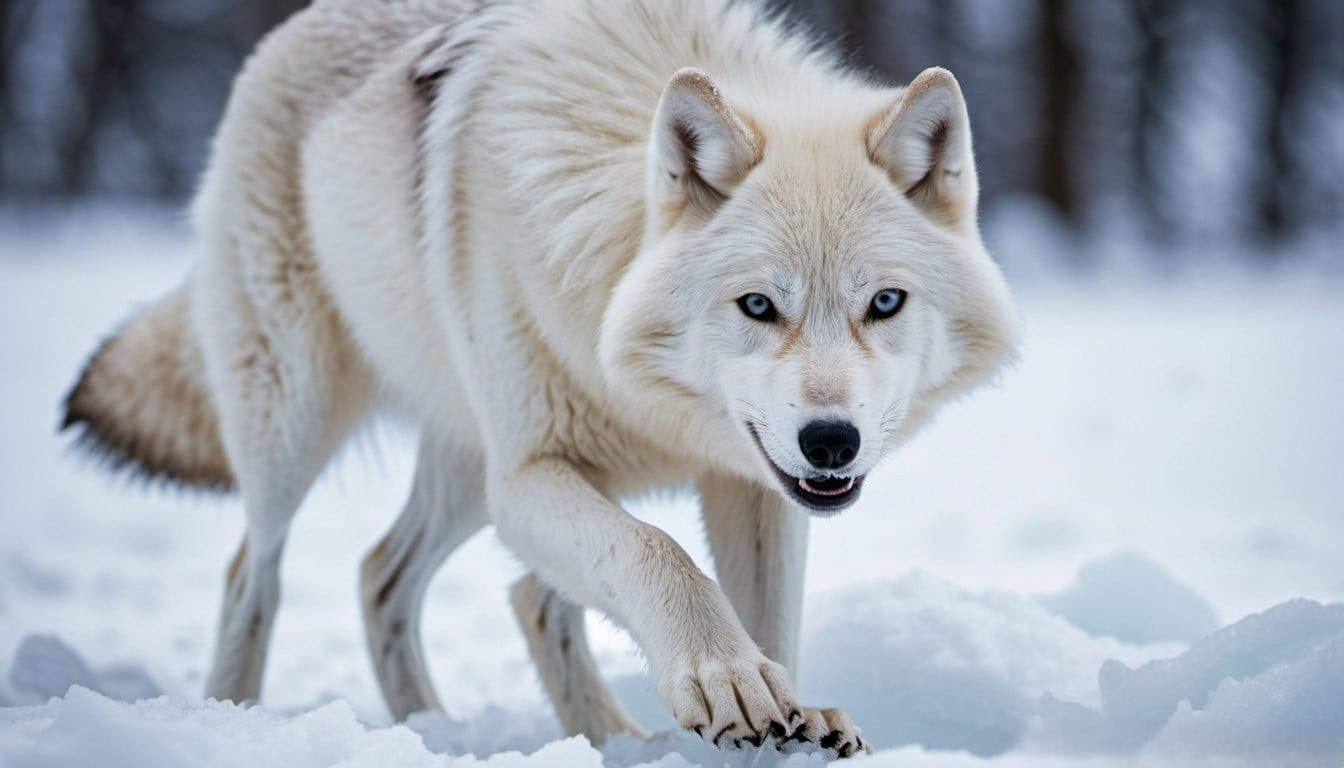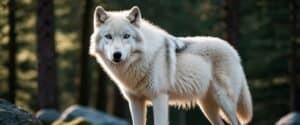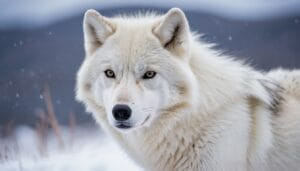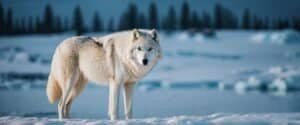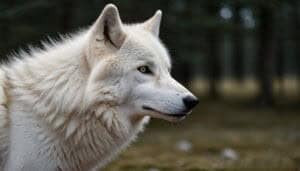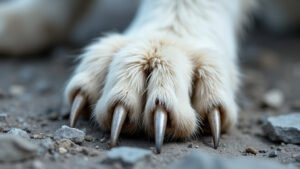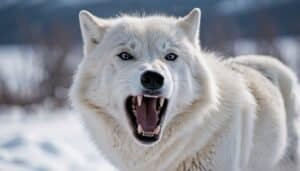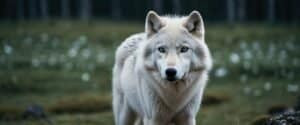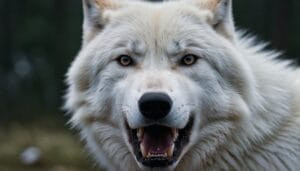Introduction
Understanding the functions of the Arctic wolf’s claws reveals much about their survival in one of the planet’s harshest environments
This article explores the multifaceted roles of these essential tools, from hunting and movement to defense and environmental adaptations. We will delve into the physical characteristics, development, and the impact of changing climates on these remarkable animals
The Function and Adaptations of Arctic Wolf Claws
Arctic wolf claws are vital tools that ensure survival in their frigid and unforgiving environment. These claws are multifunctional, aiding in hunting, movement, maintenance, and digging, each playing a crucial role in the Arctic wolf’s daily life and long-term survival
How Arctic Wolf Claws Aid in Hunting
The Arctic wolf’s claws are crucial for hunting, providing traction and grip necessary to catch prey in snowy and icy conditions
These wolves often hunt musk oxen, caribou, and Arctic hares, animals adept at evading predators in such terrain. The claws allow the wolves to gain speed and maintain stability while chasing these fast-moving animals across ice and snow
Studies have shown that Arctic wolves rely on their claws to tackle their prey effectively. The claws dig into the icy ground, providing leverage during a chase and preventing slips. This stability is vital when hunting larger prey like musk oxen, where a coordinated pack attack is often required to bring down such a sizable animal (Mech, 1970)
Using Claws for Movement in Snow
Movement through deep snow and icy surfaces is another critical function of the Arctic wolf’s claws
Unlike other canines, Arctic wolves have claws adapted to grip and break through hard, icy surfaces, giving them an advantage in their native habitat. These claws help distribute the wolf’s weight more evenly, allowing them to walk on snow without sinking too deeply
The structure of the Arctic wolf’s claws, sharp and slightly curved, helps them dig into the snow, providing traction and stability. This adaptation is essential for maintaining speed and agility while navigating their challenging environment
It ensures that the wolves can move swiftly and efficiently, whether they are chasing prey or traversing vast distances in search of food (Dawson et al., 2019)
Maintenance and Adaptations for Cold Environments
Arctic wolves maintain their claws through natural wear and tear. The constant use of claws on icy and rocky surfaces helps keep them sharp and functional
Additionally, these wolves engage in behaviors like scratching the ground or ice, which naturally files their claws and prevents overgrowth, ensuring they remain effective tools for survival
Adaptations to cold environments are evident in the Arctic wolf’s overall physiology, including their claws. These claws are composed of keratin, which remains strong and durable even in freezing temperatures
This resilience is crucial, as the claws must withstand the constant contact with ice and snow without becoming brittle or breaking (Harrington, 1985)
Digging for Food and Shelter
Arctic wolf claws are also instrumental in digging for food and creating shelter
In the harsh Arctic environment, food can be scarce, and wolves often need to dig through layers of snow and ice to find hidden caches of food or to reach buried prey. Their strong, sharp claws make this possible, enabling them to survive during the leaner months
In addition to hunting, Arctic wolves use their claws to dig dens for shelter. These dens provide protection from the severe weather and a safe place for raising pups
The ability to dig effectively into the frozen ground is a critical survival skill, allowing wolves to create a stable and insulated environment necessary for the well-being of their pack (National Wildlife Federation, 2020)
Physical Characteristics and Development of Arctic Wolf Claws
Arctic wolf claws are specialized tools that have evolved to meet the demands of their harsh environment. Understanding the physical characteristics and developmental aspects of these claws provides insight into their effectiveness and the role they play in the survival of the species
Comparative Analysis with Other Wolves
When comparing the claws of Arctic wolves with those of other wolf species, several key differences become apparent
Arctic wolves, scientifically known as Canis lupus arctos, have claws that are generally sharper and more robust than those of their counterparts in milder climates. This is a direct adaptation to their environment, where the need for effective traction on ice and snow is paramount
Unlike the gray wolf (Canis lupus), which inhabits a variety of terrains including forests, plains, and deserts, Arctic wolves are exclusively adapted to the frigid Arctic tundra. Their claws are not only sharper but also more curved, allowing for better grip on slippery surfaces. This adaptation is crucial for maintaining stability and speed when traversing icy landscapes (Mech & Boitani, 2003)
Strength and Durability of Claws
The strength and durability of Arctic wolf claws are remarkable. Composed primarily of keratin, the same protein found in human nails and hair, these claws are designed to withstand the rigors of a harsh environment. The constant exposure to ice, snow, and rocky terrain necessitates claws that can endure and remain functional without frequent breakage
Scientific studies have shown that the keratin structure in Arctic wolf claws is denser and more resistant to cold-induced brittleness compared to other canines
This durability ensures that the claws remain sharp and effective throughout the wolf’s life, allowing them to hunt, dig, and move efficiently in their environment (Dawson et al., 2019)
Development in Young Arctic Wolves
The development of claws in young Arctic wolves is a gradual process that starts from birth
Wolf pups are born with soft claws that harden and sharpen as they grow. By the time they are a few months old, the claws are fully developed and begin to exhibit the same strength and curvature seen in adult wolves
Observations of Arctic wolf packs indicate that pups learn to use their claws effectively through play and practice
Young wolves engage in activities like digging, scratching, and play-fighting, which help them hone their clawing skills. This developmental period is crucial as it prepares them for the various survival tasks they will need to perform as adults (Harrington & Asa, 2003)
The Role of Claws in Arctic Wolf Survival and Defense
Arctic wolf claws are indispensable tools not only for hunting and movement but also for survival and defense. These claws serve as formidable weapons and essential aids in various survival activities, from building shelters to defending against predators and rivals
Defense Mechanisms
Arctic wolves use their claws as a primary means of defense against potential threats
When faced with predators or intruders, these wolves can deliver powerful swipes with their claws, causing significant injury and deterring attacks. This defensive use of claws is crucial for protecting themselves and their pack members, particularly the young and vulnerable
The sharpness and strength of the claws make them effective weapons in close combat situations. Arctic wolves are known to fiercely defend their territory from other wolves and predators like polar bears
Their claws, combined with their strong jaws and sharp teeth, form a comprehensive defense system that helps ensure their survival in the wild (Mech, 1997)
Traversing Icy Terrain
One of the critical functions of Arctic wolf claws is aiding in the traversal of icy and snowy terrains. These wolves often travel vast distances in search of food, and their claws provide the necessary traction to navigate these challenging surfaces without slipping or falling
The claws act like natural crampons, digging into the ice and providing stability
This capability is particularly important during the winter months when the Arctic landscape is covered in snow and ice. The ability to move efficiently and safely across such terrain is vital for accessing hunting grounds and avoiding dangerous situations (Dawson et al., 2019)
Claws and Pack Dynamics
Claws also play a role in the social dynamics of Arctic wolf packs. Dominance and hierarchy within a pack are often established and maintained through displays of strength and aggression, where claws can be a factor. Wolves use their claws during play-fights and real confrontations to assert dominance and settle disputes
Moreover, claws are essential for activities that support pack cohesion, such as digging communal dens and hunting cooperatively
By working together to dig dens, wolves create safe spaces for raising pups and sheltering from harsh weather. This cooperative behavior is crucial for the pack’s survival and is facilitated by the effective use of claws (Mech & Boitani, 2003)
Environmental Impact and Evolution of Arctic Wolf Claws
The claws of Arctic wolves have evolved to meet the challenges of their environment, and ongoing changes in the Arctic climate continue to influence their development and function. Understanding these impacts and adaptations provides insight into the resilience and adaptability of these remarkable animals
Effects of Climate Change
Climate change poses significant challenges to Arctic wolves, including alterations in their habitat and the availability of prey. As the Arctic ice melts and temperatures rise, the terrain becomes less stable, potentially affecting the effectiveness of the wolves’ claws
With shorter winters and longer periods of thaw, Arctic wolves may encounter more slushy and muddy conditions rather than the solid ice and snow they are adapted to navigate. This change can impact their hunting efficiency and movement
Research indicates that some Arctic wolf populations are already experiencing shifts in their prey availability and distribution, necessitating further adaptation of their hunting strategies and the use of their claws (Post et al., 2009)
Evolutionary Adaptations
Over millennia, Arctic wolves have evolved claws that are perfectly suited to their harsh environment
These evolutionary adaptations include increased sharpness, curvature, and strength compared to other wolf species. These traits have been naturally selected for their effectiveness in hunting, movement, and survival in icy terrains
The claws’ design, combined with the wolves’ powerful forelimbs, allows them to dig through snow and ice efficiently. This capability is essential not only for hunting but also for creating dens and finding food caches buried beneath the snow. These adaptations highlight the importance of claws in the Arctic wolf’s evolutionary success (Mech & Boitani, 2003)
Claws and Pack Dynamics
Claws also play a role in the social dynamics of Arctic wolf packs. Dominance and hierarchy within a pack are often established and maintained through displays of strength and aggression, where claws can be a factor. Wolves use their claws during play-fights and real confrontations to assert dominance and settle disputes
Moreover, claws are essential for activities that support pack cohesion, such as digging communal dens and hunting cooperatively
By working together to dig dens, wolves create safe spaces for raising pups and sheltering from harsh weather. This cooperative behavior is crucial for the pack’s survival and is facilitated by the effective use of claws (Mech & Boitani, 2003)
Conclusion
The Arctic wolf’s claws are remarkable adaptations that play crucial roles in their survival in one of the harshest environments on Earth
These claws are essential for hunting, providing the traction and grip needed to catch prey in icy conditions. They also aid in movement across snow and ice, ensuring stability and speed. The physical characteristics of the claws, including their sharpness and strength, distinguish them from other wolf species and highlight their specialization for cold environments
Additionally, the claws are vital for defensive purposes, offering protection against predators and enabling the wolves to assert dominance within their pack
Their role extends to social dynamics and cooperative behaviors, such as digging communal dens, which are essential for pack cohesion and survival. Furthermore, the claws of Arctic wolves have evolved to meet the demands of their environment, and they continue to adapt in response to changing climatic conditions
As the Arctic continues to face the impacts of climate change, understanding the function and adaptations of Arctic wolf claws becomes increasingly important
These insights not only highlight the resilience and adaptability of Arctic wolves but also underscore the intricate ways in which they interact with their environment. The continued study of these fascinating creatures will provide valuable information for their conservation and the preservation of their unique habitat
